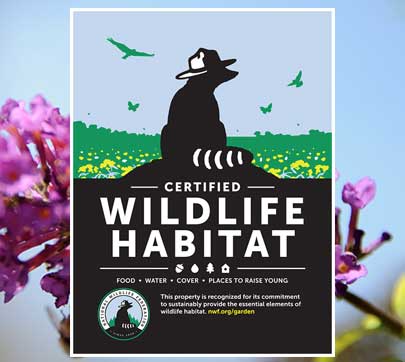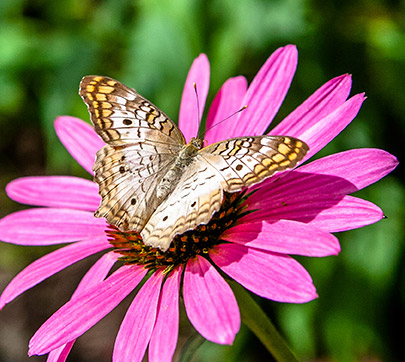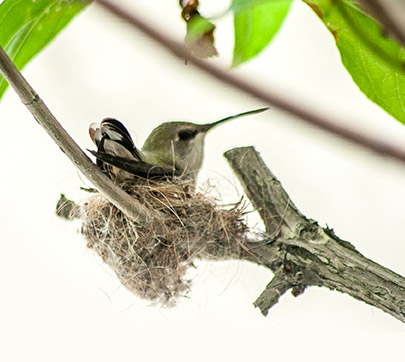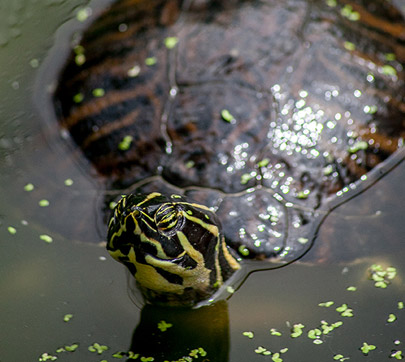Conservation & You
Turn your yard into a Certified Wildlife Habitat
Whether you live in the quiet of the country or the buzz of the city, there’s a home to be had for wildlife. The National Wildlife Federation (NWF) provides a list of steps for creating your own healthy and sustainable wildlife habitat. Once your work is complete, you can order an official NWF sign to proudly display in your habitat. Are you ready to make a home for wildlife? Dust off your gardening tools and let’s go!
There are four major components the NWF needs you to incorporate for a certifiable habitat: food, water, cover and a place for wildlife to raise their young.
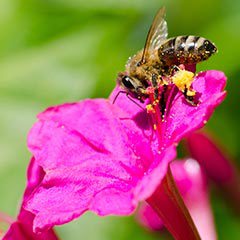 Step 1: Give ‘em grub
Step 1: Give ‘em grub
There are many shrubs, bushes and trees that provide nectar, seeds and other nutrients animals need to grow and survive. Try using plants native to your area, because they’re already adapted to the geographic area, and wildlife will be used to them. When you’re choosing your plants, make sure you have at least three of the following to get certified (these can be grown as plants or added to feeders):
- Seeds from a plant
- Berries
- Nectar
- Foliage/Twigs
- Nuts
- Fruits
- Sap
- Pollen
- Suet
- Bird Feeder
- Squirrel Feeder
- Hummingbird Feeder
- Butterfly Feeder
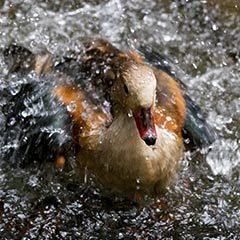 Step 2: Got water?
Step 2: Got water?
Now more than ever, it’s important to keep wildlife supplied with clean water and away from the dangers of pollution or drought. If you live near a natural water source like a pond, lake or spring, that’s great! Create your habitat close to it, and animals will have a place to bathe, drink and possibly reproduce. If you don’t have a babbling brook nearby, never fear. According to the NWF, the easiest water source to install is a birdbath. Just be sure to keep it clean and fresh. To be certified for water, your habitat will need at least one of the following:
- Birdbath
- Lake
- Stream
- Seasonal Pool
- Ocean
- Water Garden/Pond
- River
- Butterfly Puddling Area
- Rain Garden
- Spring
Step 3: Build a fort
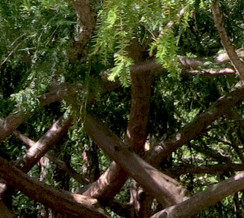
Wildlife need places to hide from threats or keep cover if weather gets bad. Shrubs and brambles are a great natural source of cover. Dead trees can be another good option, too, as many animals find shelter inside cavities or use branches for nests. To have a certified shelter, make sure your habitat has at least two of the following:
- Wooded Area
- Bramble Patch
- Ground Cover
- Rock Pile or Wall
- Cave
- Roosting Box
- Dense Shrubs or Thicket
- Evergreens
- Brush or Log Pile
- Burrow
- Meadow or Prairie
- Water Garden or Pond
Step 4: Room to grow
Create space for families to grow. Animals need a place to raise their young where they feel safe and have plenty of resources around them. A wildlife habitat is more than just a spot for animals to visit; it should be a place where animals can complete the full lifecycle. The natural cover (like shrubs and brambles) you provide can double as a suitable place for animals to raise their young. For certification, make sure your habitat has at least two of the following:
- Mature Trees
- Meadow or Prairie
- Nesting Box
- Wetland
- Cave
- Host Plants for Caterpillars
- Dead Trees
- Dense Shrubs or a Thicket
- Water Garden or Pond
- Burrow
Step 5: Make it official
After you’ve built and groomed your habitat, visit www.nwf.org/CertifiedWildlifeHabitat to register your habitat and have it officially certified. Even if you don’t take this final step, you’ve done an amazing job creating a safe and nurturing place for animals to live!


